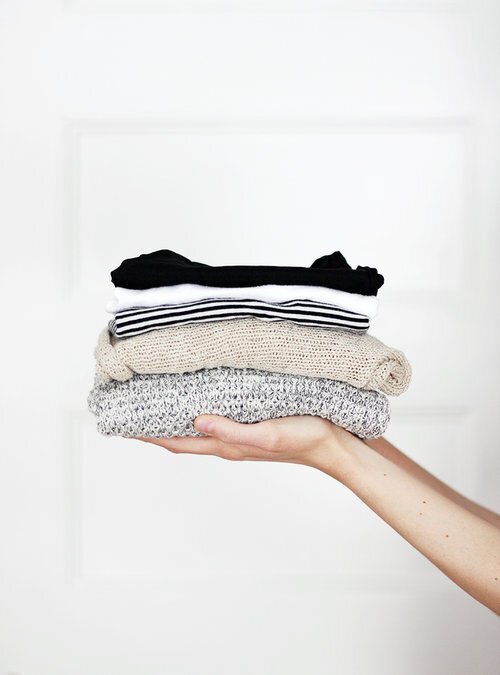
Is It Okay To Buy Fast Fashion Secondhand?
Is Secondhand Fast Fashion Sustainable?
When I began writing this piece I had my personal opinion and conclusion to this article all ready to go. I have attended many clothing swaps in the past few years and become annoyed with ones which ban fast fashion items from participating. I’ve consistently thought that the excess of clothing in our world is too great not to take advantage of every secondhand piece available.
“We are shopping more than ever and we are discarding more than ever. So, is it okay to buy someone’s used fast fashion?”
But as I dove deeper, I realized that the answer requires a little more context. We are currently living in an unprecedented moment in fashion history. Fast fashion has taken over much of our world and turned the need to clothe ourselves into a mindless sport. We are shopping more than ever and we are discarding more than ever. So, is it okay to buy someone’s used fast fashion? Is it better than buying it straight from the retailer, or is it just perpetuating the consumption cycle? The conclusion, just like sustainability advisement in general, is far more complex than “yes” or “no”.
For this piece, I called on my whip-smart sustainable fashion friends to weigh in with their thoughts. Getting each of their varied perspectives was invaluable in coming to the realization that this topic is far from simple. Most of them agreed that we must use what we already have instead of constantly creating new.
Thrifting Is Accessible
Buying secondhand gives people the opportunity to begin their journey into sustainable fashion—even if they don’t have the means to buy new consciously made options.
When people object to buying fast fashion, they claim “don’t show your support by giving them more money”, and by buying secondhand, you’re not actually contributing to their success—they don’t receive those dollars.
Thrifting is a cheap way to vote with your dollars and avoid giving to questionable corporations. Though the true benefit of buying secondhand is not necessarily the lowered price tag, but rather the ability to get unusual pieces without continuing to harm the planet.
I think it’s a great compromise between wasting less, spending less and having a lot of stylish options.
Thrifting Expands Our Options
I have always been a fan of the outrageous when it comes to dressing. Though I’m much less experimental than I used to be, it’s so exciting to know that I could get my hands on a silver vinyl bag or spandex jumpsuit if the feeling struck. The reality is that these fabrics and colors are just not feasible (yet) without the use of toxic chemicals, so being able to enjoy those trends which have come back in style, without creating new carbon footprints, is quite satisfying.
Secondhand clothing doesn’t use resources, energy, and exports like ‘firsthand’ fashion does. Purchasing secondhand means it was probably done locally, benefiting a thrift/charitable organization, and otherwise extends the life of a garment that would be sent to the landfill.
Buying secondhand keeps clothing from, or at least prolongs the process of, ending up in landfills. Each year Americans throw away about 11 million tons of clothing and much of it ends up coming from excessive production of fast fashion companies. An alternative to this is to give to secondhand shops, in an attempt to keep these textiles alive a little longer.
If one of the main problems fast fashion created is waste, and shopping secondhand is a waste reduction method—then by nature, eliminating waste created by fast fashion is a good idea.
But Is This Just Part Of A Wasteful Cycle?
The “resale market” has become a $20 billion dollar industry in its own right and has begun the transition to outpacing traditional fast fashion. This is wonderful news to those of us interested in changing the way that people consume, though it may be hiding the fact that it could be another form of mass consumption. With the rise of organizational fads like the Marie Kondo method, individuals have been getting rid of their possessions left and right, leaving thrift shops with maybe more than they can manage.
It isn’t a world that exists outside fast-fashion in some ‘recycled clothing’ heaven, it’s PART of the fast fashion world. It is the pit-stop for fashion (vintage, sustainable, ethical or fast) between birth and its inevitable demise to landfill.
Buying fast fashion secondhand may reduce the guilt we have for our purchases, though it may not reduce our overall impact. Fast fashion is fast fashion and could fall apart eventually, leaving us wanting more, just like the customers who originally purchased them. Maggie Pa summed it up well when I called on my friends at Beyond The Label to give their expert opinions:
My criteria for purchasing secondhand typically are a) will I wear this? and b) is this item good quality? There is no point in purchasing an item that will just fall apart or be something that I no longer want to wear after two or three wears. While I do try to stay away from non-organic materials, if it’s a piece I will love and treasure I don’t mind.
Maybe it’s not so black and white. It’s okay to buy fast fashion secondhand, though definitely wise not to completely fill your closet with it. It’s not just smart for the planet, and it’s smart for your wallet to employ moderation when it comes to these pieces so that you aren’
t left spending constantly to replace the low-quality items.
I try not to, but at the same time, it’s continuing the life cycle of a garment that is cheap and would normally be discarded. If you find a fast fashion piece that you adore secondhand, I’d say go for it but I wouldn’t make it a habit or your closet will shift to more cheaper-quality clothing and the resale value is a lot less. Overall, I would say no more than 20% of the secondhand pieces you get should be fast fashion brands—but of course it’s a personal preference.
Buying secondhand fast fashion can be a joyous way to try out new trends with low risk of feeding the consumer monster directly. There is so much clothing out there already that it would be a good idea for all of us to invest in more secondhand pieces. It’s vital for us to expand the accessibility of this movement and avoid discouraging those new to ethical fashion from participating in any way they can. Sometimes casting the net wider means some people will be obtaining secondhand fast fashion.
“A shift to a more conscious lifestyle is mainly about taking the time to think through your purchases, actions, and the inevitable consequences.”
However, it’s important not to forget that sustainable fashion is a growing movement for a reason, these low-quality pieces aren’t built to last, contain toxic chemicals, and were created in poor conditions. Secondhand fast fashion seems to be a means to an end because, in a perfect world, it wouldn’t even be a factor.
I maintain that it’s not a one-size fit all solution because in this emerging section of the industry there are still so many gray areas. We all crave concrete advice, but a shift to a more conscious lifestyle is mainly about taking the time to think through your purchases, actions, and the inevitable consequences. Nothing in this world is without consequence and we’re all just doing our best to make sense of it all.
Audrey Stanton was born and raised in the Bay Area and is currently based in Los Angeles. She works as a freelance writer and content creator with a focus in sustainable fashion. Audrey is deeply passionate about conscious living and hopes to continue to spread awareness of ethical consumption.




